Nothing is as disheartening as seeing customers unsubscribe or stop using your service. But it's an inevitable part of business: Some of your customers, for whatever reason, may decide to stop doing business with you.
An above-average churn rate, though, is an indicator that your business has problems. An upward churn or attrition rate can cripple a business and cause revenue to dwindle.
Average churn depends on your industry:
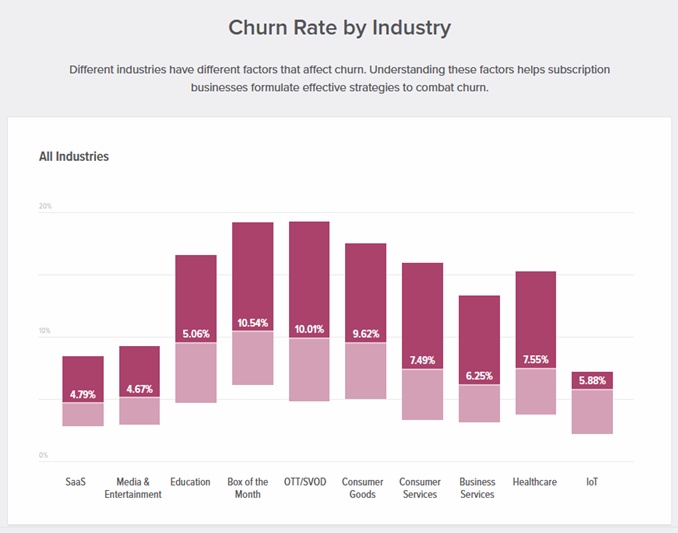
Source: Recurly
This article contains a step-by-step strategy that you can use to win back lost customers through targeted content, whatever your industry.
It pays to pay attention to customer retention
Customer retention is critical for a growing business. Acquiring a customer can cost five times as much as retaining one.
If you want to acquire a new customer, you must first identify people who fit your ideal customer demographic, then run a marketing campaign to convince that person to try your service or purchase your product. All that costs time and money.
Say you run a pay per click marketing campaign. You have to design the ad, define the targeting, and set aside a campaign budget. When a person clicks on the ad, they are sent to a landing page, which you have to create. Once they are on your email list, which you have to pay for, you send them links to content on your blog, which someone has to write. At the end of the process, you're lucky if one person in 100 decides to try your service or purchase your product.
Each stage in the customer acquisition process is a financial investment. But you can skip most of it in the case of clients who have tried your product or service. If you provide a good product, they have a degree of trust in what you offer. As a result, it's easier to sell to that person again.
Lowering your churn rate 5% can increase profits anywhere from 25% to 95%, according to Small Business Trends. If you are looking to ramp up profits, focusing on customer retention is a no-brainer.
The following five-step strategy will help you use targeted content to win back lost customers.
1. Let data be your guide
The first commandment of winning back lost customers is to know them. Have a clear picture of who your customers are and what their preferences are.
Information you gather about your customers will help you understand which customers are worth pursuing and what strategies will yield the best results.
Start by segmenting your customers into groups. One tried-and-tested method is the recency, frequency, monetary (RFM) model:
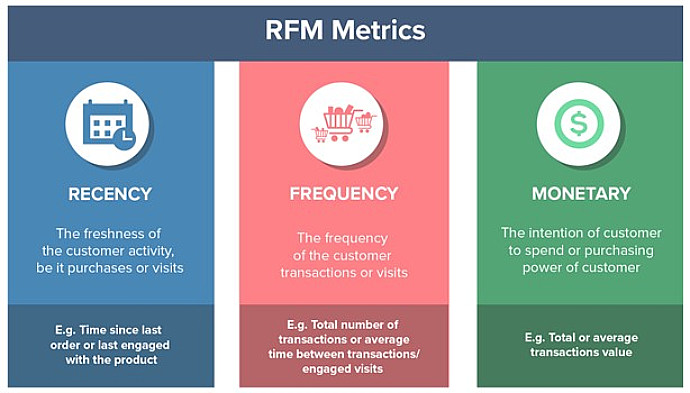
Source: Clever Tap
When conducting an RFM analysis, you give each customer an RFM score between one and five. A score of five is a high score, and a score of one, two, or three shows that there is work to be done. Your best customers will have a score of 5-5-5. Take a look at this table as an example:
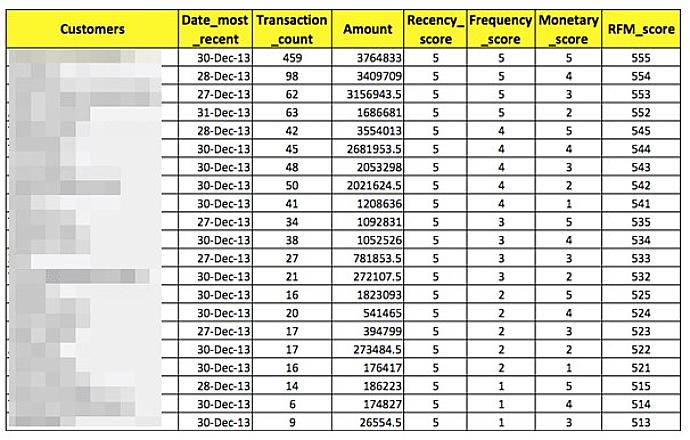
An RFM analysis of customers will help you keep track of what your customers are doing. Through the analysis, you can start to place the customers into groups and identify trends in their buying habits.
(For a more detailed guide on using the RFM model, check out this article.)
2. Find out why the customer left
Customers leave services for a host of reasons, including poor customer service, pricing concerns, and better alternatives offered by your competitors.
One of the easiest ways to collect customer feedback is to send customers an exit survey. You can also combine surveys with other customer feedback strategies. Exit interviews, for example, will probably provide you with more insight than a survey. Of course, it's harder and more time consuming to conduct interviews, so you have to find the right balance for your business.
The response rate for any type of customer exit feedback will likely be low. To improve the response rate, consider using an incentive.
The following graphic outlines reasons customers leave and how you might win them back:
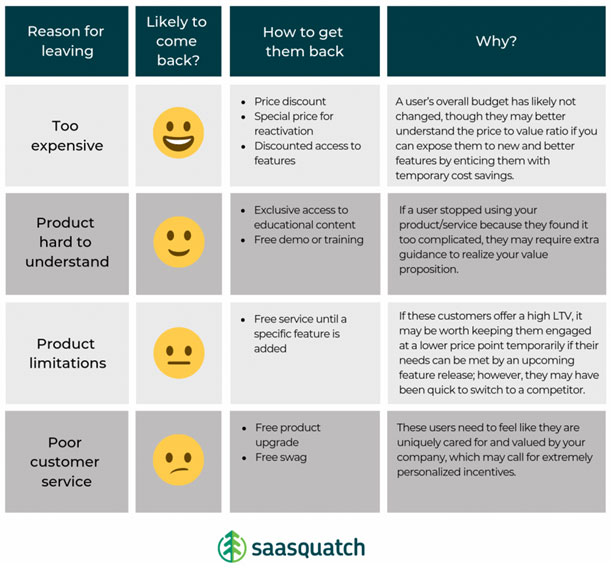
Source: Saasquatch
As you collect responses from your customers, you will gain insights about the problems they face. That data will come in useful as you devise your strategy to reduce churn and increase customer retention.
3. Devise your customer retention strategy
You've completed your research. You've broken your customers down into groups based on their spending habits and engagement, and through that analysis you have gained valuable insights into the customer journey. In addition, you've identified problems that customers have encountered with your company.
You next need to devise marketing strategies that do two things:
- Anticipate the customer journey, so you can offer products or services to people when they are most likely to buy something based on their purchasing habits
- Devise a marketing strategy to win back lost customers based on an understanding of the insights you've gained about your customers
Let me give you a hypothetical example of how it might work.
If you run an SEO agency and know that 76% of your clients increase their budget between months 9-12, you can prepare a project proposal that anticipates that need. You can also start discussing marketing goals and share projections about the impact of a higher budget on their business.
After anticipating the customer journey, you can create a strategy aimed at winning back lost customers. You might have identified that a fixed 12-month project was an issue with customers because they can't guarantee cash flow over such a long period. You might then offer a lost customer the chance to work with your agency for six months, with the option to cancel the contract at no risk with a 30-day notice period.
4. Remind your lost customers of what they are missing
There are straightforward, effective ways to use targeted content to win back customers.
It's for good reason that marketers love using the fear of missing out (FOMO) to drive engagement and sales. FOMO thrives on a customer's desire not to let a good opportunity slip away.
FOMO content is often used as part of a cart-abandonment sequence. However, it's equally effective as part of a promotion.
Here's an example of a great FOMO email by clothing shop Boden:
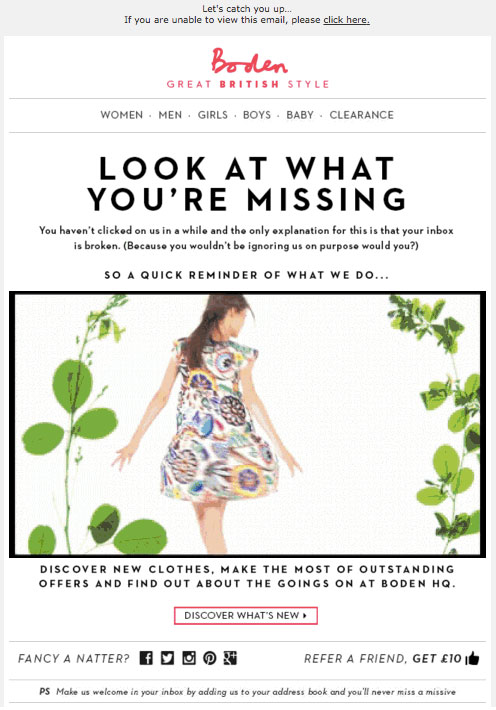
Source: Ometria
The above email is effective because…
- It reminds customers of things they are missing.
- It employs excellent visuals to get the message across, which also helps to establish brand identity.
- It has a clear call to action in the form of the "Discover What's New" tab.
Your message to clients about what they are missing should incorporate those points and many more. You can even tailor it to buyer persona.
5. Offer retention incentives
One of the simplest ways to draw customers back into your fold is to give them incentives for returning. Those incentives could be discounts, upgrades, freebies, giveaways, or others.
Offers should be specific about what the customer stands to get, and they should employ lots of visuals that make the outreach captivating. Also, they should make the customer feel wanted and important, and they should have a clear CTA.
Use data from your RFM analysis to understand which offers and incentives your lost customers would find most appealing.
For example, in 2016 a telecom company tested four win-back offers on 40,000 customers, and some worked better than others. The results, according to Harvard Business Review:
- Discount ($20 off for six months): 45% success rate and 668% ROI
- Upgrade ($35 movie channel free for three months): 41% success rate and 793% ROI
- Bundled ($20 off for six months, plus a $35 movie channel free for three months): 47% success rate and 302% ROI
- Tailored (customers who left because of price got a discount, and those who left because of service got an upgrade): 45% success rate and 596% ROI
Automating your product offers can proffer advantages; with the right proposals management software, you can more easily close deals.
* * *
Without customers, no business can exist. Wal-Mart and Sam's Club founder Sam Walton said, "There is only one boss: the customer. And he can fire everybody in the company from the chairman on down, simply by spending his money somewhere else."
When you notice that you are losing customers, don't throw your hands up in despair. Some amount of churn is normal for every business, and the tactics outlined in this article can help to bring back customers even when they leave.
However, to keep customers from leaving in the first place, every business should be focused on keeping them satisfied and happy by prioritizing customer service. Look at your customers as a gift: Recognize and reward customer loyalty; encourage customer feedback; and promptly respond to any concerns or difficulties with your product or service. Also, be creative and innovative in coming up with products and services that address the pain points of your audience.
Do all that, and you'll keep customers pleased and happy.




